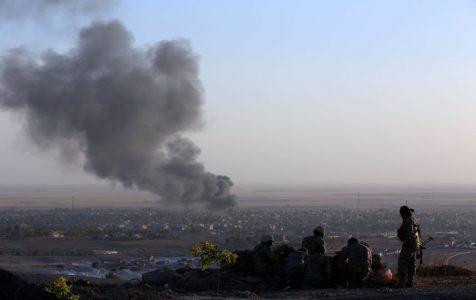
Islamic State roots run deep in Middle East discontent
As the Kurdish-led, US-backed Syrian Democratic Forces (SDF) are slowly clearing the Islamic State (IS) from its last Syrian foothold of Baghouz in the east, there has been a steady stream of media comments and forecasts about the “final defeat of IS.”
President Donald Trump, since announcing US troops will withdraw from Syria, has repeatedly said IS is “finished.” Trump’s White House has likewise adopted a “Mission Accomplished” slogan.
But one should be cautious when linking the words “Islamic State” and “defeat.”
The most pertinent consideration is how to define and measure defeat. If one defines success as eliminating IS’ military capabilities and territorial control, then it can be said that IS appears to have been militarily defeated.
But the current situation takes me back to 2006-2007, when I served as the Turkish point of contact at Kirkuk in Iraq. I recall how the US Army with its surge strategy defeated the Sunni insurgency in Anbar province. When measuring success by operational metrics in those days, we saw a rapid and significant decline in violent attacks in Iraq and in the number of civilians killed, as well as a sharp reduction in attacks on US soldiers and military casualties. Other yardsticks — such as suicide attacks, roadside bombings and security forces killed — showed similar declines as well. In a nutshell, the surge as an operational-military strategy was successful.
Sadly, because of the complex, treacherous nature of state vs. nonstate confrontations, this operational victory couldn’t be translated into a sustainable political victory, and the surge strategy became one of those primary antecedent conditions yielding to the emergence of IS as a splinter group of al-Qaeda. The surge couldn’t completely destroy al-Qaeda cells in Iraq, and those cells simply went underground and waited for the right time to return.
Nowadays, I sense the same operational euphoria in the air, like we felt at the end of 2007 in Iraq. If I’m asked about IS, which rose to great prominence with its capture of Mosul in June 2014 and now is said to be nearing its end at Baghouz, I would highlight a couple of points.
First, IS was an effective war machine that projected good amounts of both offensive and defensive operational capabilities from 2014-2018. It was a quasi-state aiming to expand its territorial control — taxing people, issuing IDs, running borders and providing basic services to millions under its control for long period of time. It was a propaganda machine whose sagas and strategic narratives lured thousands of people from all over the world. Most importantly, it is — not was — an influential ideological hub appealing to thousands in Iraq and Syria and perhaps tens of thousands globally.
In this sense, we shouldn’t underestimate what IS is still capable of in Syria and Iraq. Some lingering questions cloud the potential for peace and stability there in particular, and all over the world in general.
Some people optimistically see the pending victory against IS at Baghouz as the cure to eradicate a deadly disease. But what if that victory is actually just a short-acting painkiller that masks a symptom of something even more insidious in the Middle East?
Are the alienated Sunni political structures in Iraq and Syria the “first victims” of IS’ terrorism that should urgently be engaged after the IS’ defeat? Or are they a potential fertile breeding ground for the resurrection of IS-like structures that should be kept from developing in political and material terms?
I believe it’s premature to talk of post-IS settings in Iraq and Syria. Despite the demise of IS, there are still three types of sentiments causing armed mobilization in northern Syria to consider: first, Sunni/Salafi; second, Kurdish ethno-nationalist; and third, pro-Iranian pan-Shiite.
These three sentiments have all been adapted as proxies by countries with stakes in Syria. Unfortunately, none of those states with a military presence in Syria are willing to disrupt the zero-sum game among these three.
Will the zero-sum game continue in the post-IS setting? This question — concerning who can diminish/eliminate these sentiments and how this can be done in a synchronized fashion — will remain, as the world waits for peace and stability in Iraq and Syria after the so-called “defeat” of IS.
In the meantime, the ideology and propaganda of IS will be hovering like a ghost over Iraq and Syria, waiting for the proper conditions for it to reappear.
Source: Al Monitor





